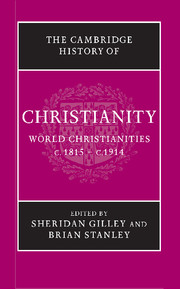Book contents
- Frontmatter
- 1 Introduction
- PART I CHRISTIANITY AND MODERNITY
- PART II THE CHURCHES AND NATIONAL IDENTITIES
- 14 Catholic Christianity in France from the Restoration to the separation of church and state, 1815–1905
- 15 Italy: the church and the Risorgimento
- 16 Catholicism, Ireland and the Irish diaspora
- 17 Catholic nationalism in Greater Hungary and Poland
- 18 Christianity and the creation of Germany
- 19 Anglicanism, Presbyterianism and the religious identities of the United Kingdom
- 20 Protestant dominance and confessional politics: Switzerland and the Netherlands
- 21 Scandinavia: Lutheranism and national identity
- 22 ‘Christian America’ and ‘Christian Canada’
- 23 Spain and Portugal: the challenge to the church
- 24 Latin America: the church and national independence
- 25 Between east and west: the Eastern Catholic (‘Uniate’) churches
- PART III THE EXPANSION OF CHRISTIANITY
- Select General Bibliography
- Chapter Bibliography
- Index
- References
15 - Italy: the church and the Risorgimento
from PART II - THE CHURCHES AND NATIONAL IDENTITIES
Published online by Cambridge University Press: 28 March 2008
- Frontmatter
- 1 Introduction
- PART I CHRISTIANITY AND MODERNITY
- PART II THE CHURCHES AND NATIONAL IDENTITIES
- 14 Catholic Christianity in France from the Restoration to the separation of church and state, 1815–1905
- 15 Italy: the church and the Risorgimento
- 16 Catholicism, Ireland and the Irish diaspora
- 17 Catholic nationalism in Greater Hungary and Poland
- 18 Christianity and the creation of Germany
- 19 Anglicanism, Presbyterianism and the religious identities of the United Kingdom
- 20 Protestant dominance and confessional politics: Switzerland and the Netherlands
- 21 Scandinavia: Lutheranism and national identity
- 22 ‘Christian America’ and ‘Christian Canada’
- 23 Spain and Portugal: the challenge to the church
- 24 Latin America: the church and national independence
- 25 Between east and west: the Eastern Catholic (‘Uniate’) churches
- PART III THE EXPANSION OF CHRISTIANITY
- Select General Bibliography
- Chapter Bibliography
- Index
- References
Summary
The Risorgimento, culminating in the creation of the Italian Kingdom and the collapse of the temporal power, sparked a papal Counter-Risorgimento. The clash between Italian nationalism and the Catholic Church from the restoration of 1815 to the seizure of Rome in 1870 was threefold: ideological, political and religious. This chapter probes into the roots and the flowering of all three from the pontificate of Pius VII (1800–23) to that of Pius IX (1846–78). It explores the confrontation between the national Risorgimento and the Catholic Counter-Risorgimento – and the far-reaching consequences for both.
The conflict between the papacy and patriots in Italy had deep roots, as Lorenzo Valla in the fifteenth century and Niccolò Machiavelli in the sixteenth both challenged the temporal power. Nationalist suspicion of Rome transcended the literati during the course of the Napoleonic wars, when patriots confronted a church aligned to the conservative order. Although Pius VII rejected the invitation of Tsar Alexander of Russia (1801–25) to join his ‘Holy Alliance’, he adhered to much of its conservative, antinationalist programme. In turn, the allied powers viewed the pope as a fellow victim of Napoleonic aggression, returning most of his territory, with the exception of one part of Ferrara that was transferred to Austria, and Avignon and the Venaissan which were retained by Paris. Despite these favourable terms, in June 1815 Cardinal Ercole Consalvi, the papal secretary of state, issued a formal protest against these minor losses, seconded by Pius in September. It represented a precursor of Rome’s unyielding stance in the ensuing nationalist age.
- Type
- Chapter
- Information
- The Cambridge History of Christianity , pp. 233 - 249Publisher: Cambridge University PressPrint publication year: 2005

